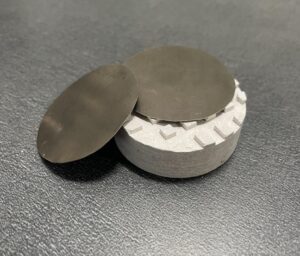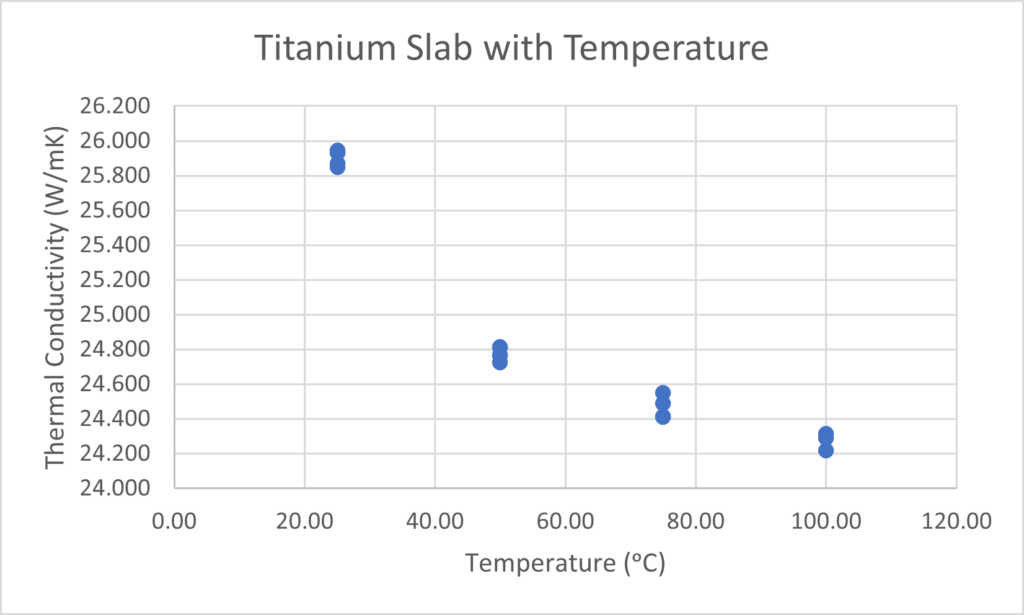In this application, we will be investigating the thermophysical properties to understand the thermal conductivity of Titanium slab.
Titanium is a lightweight metal known for its high strength and low corrosion in normal environmental conditions. Unlike other metals, titanium has a relatively low electrical and thermal conductivity. These unique properties of titanium make it useful for many parts in aircraft, spacecraft, missiles, and ships. But how is the thermal conductivity of titanium affected by changes in temperature?
We will be measuring titanium slab samples for thermal conductivity using the Measurement Platform Versatile (MP-V) with transient plane source (TPS) and our thermoelectric dry bath for testing with temperature.
A single sample of Teflon® was measured for thermal conductivity (W/m·K), thermal diffusivity (mm2/s), and volumetric specific heat (MJ/m3K) using the Measurement Platform Versatile (MP-V) with the TPS Method. There is a selection of testing modules under the TPS method that are grouped based on their testing theory. In this application, we will be using the slab module to test the titanium samples.
Titanium and titanium alloys are known for their high strength, lightweight, and excellent resistance to corrosion. Titanium is much more lightweight than other metals it still retains high strength. Although it is a highly abundant metal, its cost tends to be higher. This can be attributed to the fact that the production of titanium is very sensitive to contamination.

Figure 1. Sample of Titanium Slab
The MP-V is designed to test the absolute thermal conductivity, thermal diffusivity, specific heat and thermal effusivity of solids, liquids, pastes and powders. The MP-V features a powerful combination of the transient plane source (TPS, ISO 22007-2) and transient hot-wire (THW, ASTM D7896-19) methods with a variety of sensors that are compatible with it.
Transient methods share similar theories with differences that are specific to their primary design. The sensors are electrically connected to a power supply and sensing circuit.
An electrical current passes through the sensors and creates an increase in temperature, which is recorded over time. The heat generated is then diffused into the sample at a rate dependent on the thermal transport characteristics of the material.
The MP-V features the proprietary intelligent Transient Plane Source (iTransient) function that is designed for automation of testing and analysis. iTransient requires only the sample name as user input and the appropriate sensor and test parameters for each individual sample are determined.
The MP-V with the TPS Slab module is used to measure the thermal conductivity of thin sheet materials (with moderate to high thermal conductivity) and of uniform thickness. Measurements can be made symmetric or asymmetric.
To measure the thermal conductivity of titanium using the transient plane source method, two samples of titanium are placed on top of one another (symmetric configuration) with the TPS sensor sandwiched in the middle. This TPS sensor acts both as a heat source for increasing the temperature of the sample and a “resistance thermometer” for recording the time dependent temperature increase.
When performing a TPS slab measurement, an insulator is placed above the top sample and below the bottom sample. This enforces the boundary condition such that there is no heat transfer to the upper and lower edges of both samples.
The intelligent Transient Plane Source (iTransient) application was used to determine optimal measurement parameters for the sample to achieve optimal temperature rise and thermophysical property measurements.
Table 1. Measurement results of titanium slab samples.
| Temperature (ᵒC) | Thermal Conductivity (W/m·K) | Thermal Diffusivity (mm2/s) | Volumetric Specific Heat (MJ/m3K) |
| 25 | 25.91 | 9.44 | 2.74 |
| 50 | 24.78 | 9.05 | 2.74 |
| 75 | 24.47 | 8.66 | 2.83 |
| 100 | 24.28 | 8.40 | 2.89 |

Figure 3. Thermal conductivity (W/m·K) of titanium slab samples with temperature.
Measuring the thermal conductivity of very thin conductive samples can be challenging. The TPS slab modifier allows the thermal conductivity of materials like titanium sheets to be measured accurately and efficiently.
Powell, R. W., & Tye, R. P. (1961). The thermal and electrical conductivity of titanium and its alloys. Journal of the less Common Metals, 3(3), 226-233.Pushp, P., Dasharath, S. M., & Arati, C. (2022). Classification and applications of titanium and its alloys. Materials Today: Proceedings, 54, 537-542.